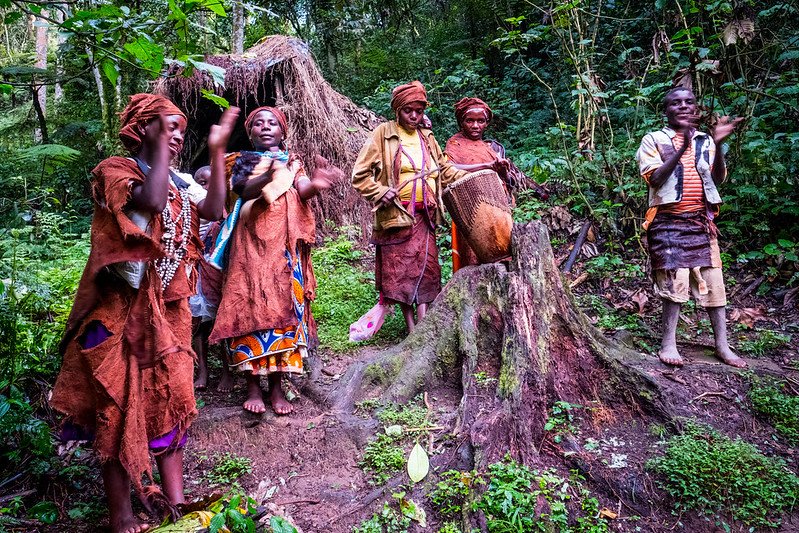Destination Fort Portal also dubbed the ‘’Jewel of the Pearl’’ boasts of possessing the biggest number of upto 56 crater lakes than any other destination in Uganda and World atlarge that you must visit while in Tooro land before you die.
Popular for her famous crater lakes also known as ‘’Ebijongo’’ in native Batooro language formed at the top of the hills which were once small volcanoes and currently now extinct, the hill tops were blown off by the violence of the eruption thousands of years ago as they were filled with rainwater.
These scenic crater lakes are not only alluring in nature given their beautiful backdrops, but are also perfect places for chilling, relaxation, exploring and encountering wildlife such as the hippopotamus and diverse bird species around their green lush flora.
With the popularly most visited three crater lakes comprising; Nyamirima, Nyinabulitwa and Nyabikere which are tucked away 900 metres from each other, just like most Tooro region crater lakes are, the names for these three among other crater lakes in the land relate to their specific qualities although these three are geographically positioned approximately 24km from Fort Portal in Kasenda sub-county. Other crater lakes found in the region with enriching traditional and cultural history include; Lake Hakigere, Lake Kanyangeye, Lake Wabikere /Kaikara, Lake Kyaninga/Hamugoma, Lake Nyamirima, Lake Nyinambuga, Lake Rukwanzi, Lake Mwamba, Lake Nyamiteza, Lake Ntanda, Lake Nyamugoro, Lake Kanyanswiiga and Lake Kitere among many others that make a grand total of 50 crater lakes not forgetting Lake Saaka – the biggest lake in the area although not a crater lake but a larva damned/blocked lake.
Therefore, Destination Fort Portal as a tourism city and top tier tourist spot is blessed with some of the alluring popular crater lakes of;
Nyamirima Crater Lake: This dark water in color crater lake just like its historical name is ‘’ Nyamirima’’ which literally translates to darkness in native Rutooro language arises its darkness from the depth of the lake and thick surrounding vegetation lying below its surface, indeed unique in its own way as its thick vegetation around brings about a feel of darkness even during the broad day light. It’s at 1427m ASL and covers a distance of 98.7 acres
Nyinabulitwa Crater Lake: Although some natives perceive it that this is of the popular three – the first crater lake to be formed, Nyinabulitwa is popularly known for harbouring lone hippopotamus, though its quite shy given its friendly over view.
Nyabikere Crater Lake: A popular water body for frogs hence its name Nyabikere, the frog noise orchestra arising from frogs while at this crater lake reveals a lot that a big amphibian population residing here is always a sign of a healthy ecosystem and Nyabikere is also a great place for bird watching as bird enthusiasts can see over 300 species of bird here including broadbills, bee eaters and fish eagles.
Lake Saaka: this is the biggest lake in the area, although it’s not a crater lake but a larva damned/blocked lake whereby at the time of volcanicity, the magma blocked the outlet and inlet of the river which stagnated thus forming a lake. It’s at 1567m ASL and it covers a distance if 143 acres.
Hakigere Crater Lake: this derives its name from the bacweezi footmark found at the edge of the lake. Initially, it was occupied by iron smiths who used to manufacture tools like hoes, spears, arrows, knives and machetes before advancing to modern smelting. It’s at 1571m ASL and covers 30.5 acres.
Kanyangeye Crater Lake: this is also known as kasindikwa crater lake and it’s the smallest in the saaka zone. The lake was named after the Colobus monkeys whose habitat was the lush forest surrounding the lake, its at 1592m ASL and covers an area of 1.19acres
Wabikere /Kaikara Crater Lake: This is located between saaka and Hakigere, the lake was named after the frogs that breed in the swamp next to it. The croaking sounds of the frogs that happened in the evenings made the locals give it the wabikere name as the origin of frogs. It’s at 1571m ASL and it covers a distance of 19.3 acres.
Lake Kyaninga/Hamugoma Crater Lake: This is the biggest and most popular in the area since it accommodates the luxurious Kyaninga lodge, the lake is surrounded by deep green and lush vegetation. It’s at 1540m ASL and covers a distance of 79.1 acres
Nyinambuga Crater Lake: This is also a bigger crater lake and also Indicated on the 20,000/= Ugandan shillings note. It is surrounded by deep green vegetation and trees, fishing is done and one can walk up to the shores it was named after a woman who is believed to have been a powerful woman in Tooro. It’s at 1366m ASL and covers a distance of 150 acres.
Rukwanzi Crater Lake: This crater lake originated its name from the calm environment and water around it. Rukwanzi in native Rutooro means a ‘’BEAD’’ and a bead is a symbol of beauty and an endearing name for beautiful girls. It’s at 1338m ASL and it covers a distance of 24 acres.
Mwamba Crater Lake: This is the biggest crater lake in Kasenda and the second biggest in Kasenda zone. The lake takes a shape of a flying bat when seen from the top. It meanders through different villages with different arms. And the Lake is a home for Mwamba tourists beach and campsite. It’s at 1304m and covers a distance of 110acres.
Nyamiteza Crater Lake: This lake is a home for Lodge bella vista in Bunyangabu and it’s surrounded by lush green vegetation (ebiteza) plus forest with steep hills. It’s at 1263m ASL and covers a distance of 75.3 acres.
Ntanda Crater Lake: This is a twin lake next to mwegenya, the word Ntanda comes from a package of food which the Batooro used to carry while giving away as gifts or food to carry along to eat when travelling. It’s at 1345m ASL, it covers a distance of 101 acres.
Nyamugoro Crater Lake: This lake has an over view of a triangular shape and it derives its name from the giant reed cover (arundo donax) that surrounds the banks .It’s at 1208m ASL and it covers a distance of 28.9 acres.
Kanyanswiiga Crater Lake: This lake derives its name from the Nswiga vegetables (Solanum nigrum) which used to grow wildly in the area as the bitter leaves are a delicacy in Tooro and still grow in the area. The lake is also surrounded by hills as well as thick trees. It’s at 1474m ASL and it covers a distance of 862acres
Lake Kitere: This crater lake is in Rwimi and one of the biggest in the locality, it has sky blue waters against a gentle slope with its indigenous name referring to a sheep’s tail. (Ekitere). It’s at 1143m ASL and covers a distance of 28.4 acres.
The list for the dramatic landscape of crater lakes found in Tooro region alone is endless, as besides experiencing the chilly Fort Portal Tourism city’s weather, enjoying sumptuous local cuisines plus visiting tourist sites and attractions of; Sempaya Hot Springs and Tooro Semuliki wildlife reserve, Amabeere Ga Nyinamwiru, Top of the World, catching scenic views of the snow-capped glaciers Rwenzori mountains, enjoying the cool local brew and partying all night plunging into a night thrilled nightlife experience in Tooro land! Vising these scenic crater lakes should be part of your trip bucket-list during your days on earth.
As the inaugural annual Cultural and Tourism festival dubbed ‘’Ekyooto Ha Mpango’’ nears – slated to take place between the 25th till 28th November 2021 in Fort Portal Tourism city, part of the festival sports will include showcasing these and more charming crater lakes located in the most pristine lowlands of Tooro region as artists, tourists, visitors and exhibitors will be destined to enjoy a glance of these bravura natural resources found in the Western region of destination Uganda.
This year’s first edition of the festival will also comprise segments such as Royal tours where King Oyo will navigate guests from other Kingdoms around key destinations in Tooro Kingdom from the 24th till 26th this month plus host a Royal dinner gala, complete with a documentary premier of Mountain Rwenzori also known as mountains of the moon, plus the festival will have a musical and entertainment slot as well as a fashion and Art show case on 26th November, plus Ekyooto cultural business expo that will provide a platform for innovative businesses to showcase and sell their products, business clinics targeting Agro-businesses and tourism start-ups in mentorship and practical business design. Also, the festival will host Ekyooto discussions on the 26th – 27th November as well as fun filled and thrilling sports activities including; the boat Regatta, Adventure cycling, fun-run among others and a cultural music festival that will feature local talent from Tooro region and guest performances from the rest of Uganda a these include; Aziz Azion, Draei Bitsc, Beenie Gunter, Pearl of Africa Stars, Ayesiga Muzamil, Kigambo Araali, Carol Kay, Holy Trimmy, Tony Blackman, Tai Tan, Home of Talent, Sagio Mhza. Harubengo School of culture, DJ Kas Baby, Dj Regniq and more. The event will close off on the 28th November with an inter-denominational thanksgiving service and closing day brunch.
About Guide2Uganda
Guide2Uganda (www.guide2uganda.ug) is the most comprehensive source of travel information about Uganda that exists on the web, with more content on its cities & towns, accommodation, attractions, events, museums and galleries than any other online guide that currently exists for Uganda; as well as being a dynamic travel news and events driven site with fresh content added daily.
According to WeFollow & Peer Index (that measure online influence), we are among the most influential online media organizations in Uganda. Guide2Uganda was also awarded ‘’Best Destination Website in Uganda’’ by Jumia Travel Uganda in the 2018 Africa Travel Awards.
Share your travel stories & photos with the world via email: info@guide2uganda.ug




